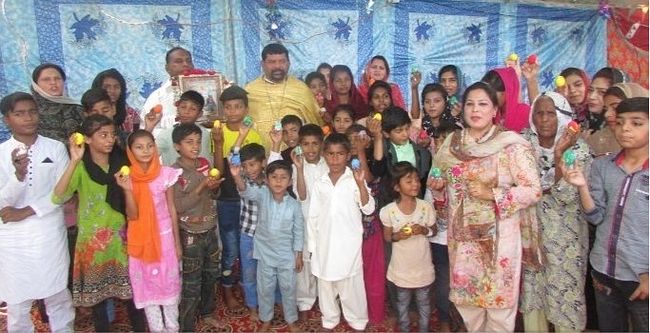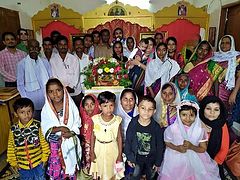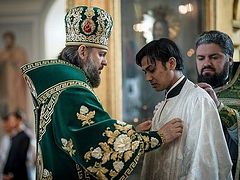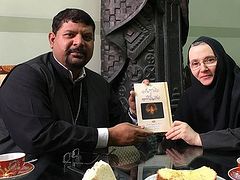The Years of Silence and the Re-establishment of ROCOR in India
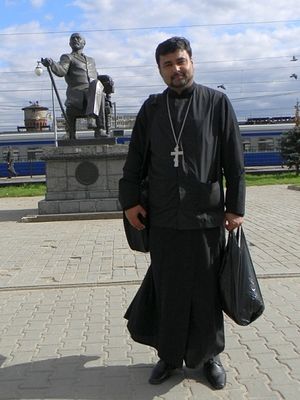 Rev Adrian Augustus. Photo: rocor.org.au With Father Lazarus having left India to pursue other activities and the cessation of talks with Father George’s movement, silence fell over the ROCOR mission in India for over a quarter of a century. This silence was maintained until the mid-2000s, when voices from India again began to call out to the Russian Orthodox Church. The fourth phase of ROCOR’s involvement in India begins with a young Anglican deacon reaching out to the Synod in the hope of being united to the Orthodox Church. Reverend Vishal Augustus was born in 1977 in Lucknow, northern India, and raised as a Roman Catholic. He later converted to Anglicanism and was ordained a deacon. By the mid-2000s, he had begun investigating Orthodoxy and exchanged correspondence with Archbishop Hilarion[1] in Australia, who recommended that he apply to study at Holy Trinity Seminary[2] in Jordanville, New York, but this was prevented by family illness.[3]
Rev Adrian Augustus. Photo: rocor.org.au With Father Lazarus having left India to pursue other activities and the cessation of talks with Father George’s movement, silence fell over the ROCOR mission in India for over a quarter of a century. This silence was maintained until the mid-2000s, when voices from India again began to call out to the Russian Orthodox Church. The fourth phase of ROCOR’s involvement in India begins with a young Anglican deacon reaching out to the Synod in the hope of being united to the Orthodox Church. Reverend Vishal Augustus was born in 1977 in Lucknow, northern India, and raised as a Roman Catholic. He later converted to Anglicanism and was ordained a deacon. By the mid-2000s, he had begun investigating Orthodoxy and exchanged correspondence with Archbishop Hilarion[1] in Australia, who recommended that he apply to study at Holy Trinity Seminary[2] in Jordanville, New York, but this was prevented by family illness.[3]
Eventually, Vishal was able to move to Australia in 2007, where he was baptised and given the name Adrian. He was ordained to the diaconate in 2009 and the priesthood in 2011, being assigned to the parish of Saint Michael the Archangel in Blacktown, New South Wales, where he still serves to this day.
His eventual involvement in the next phase of missionary work in India actually came by way of Pakistan, when a number of men who had left the Roman Catholic seminary in Pakistan contacted Archbishop Hilarion and requested to be received into the Orthodox Church. Father Adrian was dispatched to meet with them and, during his visit to Pakistan, large numbers of people expressed interest in Orthodoxy and were received into the Church.[4]
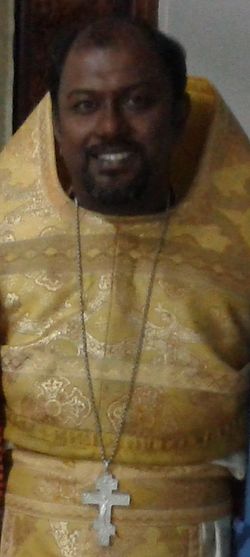 Fr. Silouan Benedict Around the same time that this was occurring, another Roman Catholic, Sunil Benedict from Bangalore, had discovered Orthodoxy through reading about the Philokalia[5] and the Jesus Prayer.[6] He reached out to ROCOR independently, and was received into the Orthodox Church, along with his wife and child, at the Russian mission in Thailand in August 2012, receiving the name Silouan. He later made contact with Father Adrian in Australia, seeking to come under his oversight as part of the larger missionary effort in Pakistan and India.[7]
Fr. Silouan Benedict Around the same time that this was occurring, another Roman Catholic, Sunil Benedict from Bangalore, had discovered Orthodoxy through reading about the Philokalia[5] and the Jesus Prayer.[6] He reached out to ROCOR independently, and was received into the Orthodox Church, along with his wife and child, at the Russian mission in Thailand in August 2012, receiving the name Silouan. He later made contact with Father Adrian in Australia, seeking to come under his oversight as part of the larger missionary effort in Pakistan and India.[7]
In something of a repetition of history, Metropolitan Hilarion and Father Adrian travelled to Sri Lanka in January 2013 with the purpose of ordaining clergymen for several Asian missions. At a hotel in Colombo, three priests were ordained for the mission in Pakistan, a reader was tonsured for India, and a monk was tonsured for the Philippine mission. Immediately following this, Metropolitan Hilarion visited Mumbai, where he served the Divine Liturgy in the house of some resident Serbian Orthodox Christians and tonsured Silouan a reader.
Silouan was ordained to the diaconate and priesthood in 2013 at the Blacktown parish and established Saint John Chrysostom Orthodox Church in Bangalore. Although a number of people were received into the Orthodox Church through the mission, Father Silouan’s work was plagued with the instability often associated with vagante movements and similar organisations. After several requests for funding from the Australian diocese of ROCOR, which were turned down partly because Father Silouan already had a well-paid job, he left ROCOR to join a non-canonical Arabic group which later turned out to be Monophysite.[8]
He later repented and returned to ROCOR, being reinstated as a priest in December 2014. This time he switched from serving the Byzantine Rite to the Western Rite, which has been a part of ROCOR’s missionary outreach since the 1960s. Nonetheless, he was not to remain stable, and was later received into the Syro-Malabar Catholic Church[9] as a priest. For this he was finally deposed and excommunicated, despite his pleas to be received back into ROCOR. His ecclesiastical realignments did not end here, however, and, discovering that he was a zealot for Eastern Orthodoxy, he was re-baptised and re-ordained by an Old Calendarist bishop.[10] He is now known as Father Thomas Benedict and serves at the parish of the Precious Belt of the Mother of God in Bangalore, assisted by Schemamonk John.
Following this debacle and the catastrophe that occurred in Pakistan,[11] Father Adrian ceased involvement in any missionary work in India or Pakistan. The mission in India was closed and the one in Pakistan was reduced to a single priest, Father Joseph Farooq, who continues to diligently serve at the parish of Saint Sergius of Radonezh in Sargodha.
The Contemporary Situation of Russian Orthodoxy in India & Conclusion
With the latest attempt at a mission in India ending in disaster, ROCOR has again been left without a presence on the subcontinent and is no longer actively engaged in missionary work in India. This is not to say, however, that the larger Russian Orthodox Church has abandoned the area. Due to a large number of Russians moving to India after the fall of the Soviet Union, the Patriarchate of Moscow has hastened to establish parishes to minister to this new generation of émigrés, predominately located in New Delhi and Goa. Along with these parishes, another movement has arisen from among the Indian Christians to find the fulfilment of their faith with the Russian Orthodox Church. In 2012, traditional Anglican bishop Polycarp Nehamaiyah[12] was received into the Russian Orthodox Church along with a number of his followers and several parishes. They now form the ‘Russian Orthodox Church in India’ under the Patriarchate of Moscow, the short history of which falls outside the scope of this work.[13]
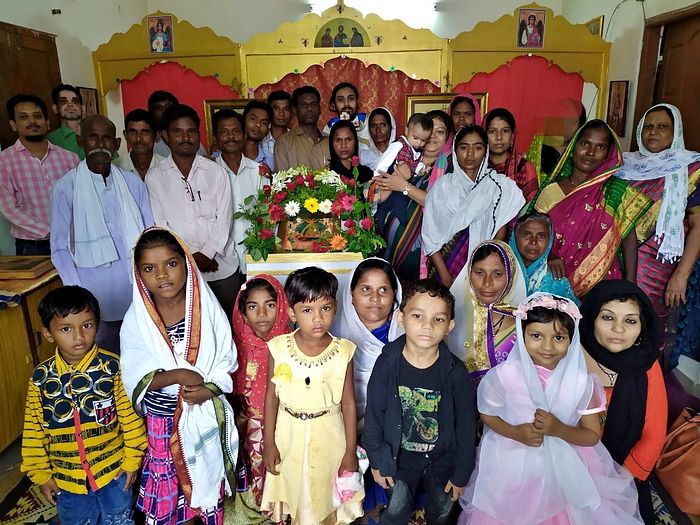 The Holy Trinity house church in Chandrapur, India; the Dormition of the Theotokos, 2019
The Holy Trinity house church in Chandrapur, India; the Dormition of the Theotokos, 2019
Viewing the entirety of the ROCOR mission in India, we can see that the Synod took the project very seriously at every stage and demonstrated both dynamism and caution in equal measure as it sought to reunite the separated Saint Thomas Christians with the Orthodox Church. Unfortunately, history was not on the side of ROCOR in this case and, unlike other missions which have flourished and continue to grow, the Indian mission never had enough momentum to develop properly and reward the optimism of the hierarchs and missionaries that were invested in the endeavour.
Unfortunately, one of the major problems with missionary work in India is the presence of numerous vagante, schismatic, and independent groups claiming false credentials, such as ordinations and qualifications, as well as people who are simply out to deceive Westerners in order to make money. All ROCOR missionaries in India reported these phenomena, to a greater or lesser degree. The history of Christianity in India, especially in Kerala, is filled with schisms and subsequent litigation, something that both Father Andronik and Father Nafanail experienced and which continues to trouble the two factions of Monophysitism in India.
Likewise the Fourth Ecumenical Council of Chalcedon hung over negotiations between ROCOR and the Indian bishops at all times. As is demonstrated by the historical records, it was this council that proved to be the stumbling block in every case. Although the Indian bishops stated several times that they were willing to accept the dogmas of the Orthodox faith, their unwillingness to accept this council prevented any advances in negotiations. It is evident that, unless the Indian Church is willing to accept the fullness of the Orthodox faith as defined by the seven ecumenical councils, and not merely in theory, then the hopes for union with the Orthodox Church that they strove for in the 1930s and 1950s will never be realised.
Whether or not ROCOR will again attempt to establish a missionary presence in India remains to be seen, but it is certain that if there is to be another chapter in this almost-century old story, it will be as fascinating, colourful, and hopeful as the others and, God willing, without the disappointment. The embers have not yet been fully extinguished: all it takes is for the Spirit to blow where it wishes and the fire will rise.
Acknowledgements
For assistance in making this project come to fruition, I would like to extend my gratitude to: His Eminence, Metropolitan Hilarion, His Grace, Bishop Jerome, Rev. Priest Adrian Augustus, Rev. Deacon Dr. Andrei Psarev (Holy Trinity Orthodox Seminary, Jordanville, NY), Dr. Meledath Kurian Thomas (Saint Thomas Orthodox Theological Seminary, Nagpur, Kerala, India), Khouria Dominica Cranor (Father Lazarus Moore Foundation), Nicholas A. Ohotin (Archive of the Synod of the Bishops of ROCOR, NY), and George Alexander (Orthodoxy Cognate PAGE Society).
Afterward: Within the past two years, there have been more missionary trips by a ROCOR priest to India, which have resulted in many baptisms. Fr. Athansius Kone of Hawaii has been heading missionary visits to a 100,000-strong group of Prostestants who are interested in entering into the Orthodox Church. We ask our readers to keep Fr. Athanasius, his assistants, and all of these potential Orthodox Christians in their prayers.
* * *
Appendix I
Statement by the Theological Commission of the Malankara Orthodox Syrian Church
Catholicate Office, Devalokam,
Kottayam.
November 21, 1953.
After a long and most profitable discussion it was decided to accept the following statement:
According to the teachings of the Orthodox Syrian Church the Second Person in the Trinity, the Logos and the Son of the Father, Who has no beginning but is begotten of the Father, of one substance with the Father and the Holy Ghost, is uncreated. He, without any change from the Divine state, by the will of the Trinity for the salvation of mankind, took flesh and became man.
He truly suffered in body and was crucified, dead and buried, descended into hades and the third day rose again from the dead, ascended into heaven and sits on the right hand of the Father in Glory.
By becoming man He did not merely dwell in a righteous person who was born of the Virgin, but He Who is true God took flesh from the Virgin by the Holy Ghost and became perfect man. In the Incarnate Lord the two natures (i.e. human and divine) are inseparably united. In this union the divine nature did not get changed into human, nor the human into divine, nor did it get mixed or confused or anything new formed. One did not get destroyed by the other, but two natures (i.e. perfect divine and perfect human without sin) got inseparably and eternally united. This union is indeed most mysterious. After this union there cannot be any separation into two persons or division into two natures. He is one person and His nature is one. In Him there is one will and one operation. He is perfect man and perfect God. At his death His divinity did not leave either the soul or the body but was in both.
The great or the Byzantine Eastern Orthodox Churches define their belief in Jesus Christ as God-man by accepting the theological language formulated at the Council of Chalcedon in 452 A.D.
According to it the mystery of the incarnation can be best expressed by the use of four famous negations. These safeguard Christians from erroneous assertions and yet make no attempt to define precisely the character of the union between divine and human in the person of our Saviour.
The Chalcedon doctrine declares that Jesus Christ is one Person in Whom two natures, divine and human, are united without absorption or confusion, without admixture or change, without division and without separation.
This first negation stands as a barrier against those who teach that human nature in Christ is an inferior one and is consumed or absorbed in the fire of His Divinity.
The second refuted a more settled suggestion that manhood in Christ had to be changed before it could be brought into hypostatic union with God.
The third rejects the notion that in Christ divine and human are not united, but only co-exist in the same Person like two parallel lines which can never meet.
The fourth repudiates the idea that the Logos will discard His humanity after the last judgement and the incarnation will thus be brought to an end.
The Chalcedonian formula can be summarised as a teaching that human nature becomes hypostatically united with God in the Second Person of the Holy Trinity without losing however its finite creaturely character. This union elevates it to its greatest possible height of perfection and retains it on that level for ever and ever.
The Incarnation is a great mystery. What is a paradox to reason is a fact to faith. Just as it is impossible to understand the person of God except as triune—as three and one at the same time—so it is impossible to understand the nature of Christ except as mono-dio—as one and two at the same time. Christ is Perfect God and Perfect Man with perfect nature of God and Man and with Perfect will of God and Man. The two natures and wills are so united and in such a harmony that we cannot say they are two without immediately asserting that they are one. And yet as one does not supersede the other we cannot say they are One without immediately asserting that they are two. Therefore, we believe Jesus Christ to be Perfect God and Perfect Man, with a human-divine nature mysteriously united and a human-divine will wonderfully harmonised without becoming a third nature or will, and without admixture or separation. We can only say that Jesus Christ is the God-Man.
Appendix II
The Office for the reception of Archimandrite George (Tharian) into the communion of the Orthodox Church
Archimandrite George is brought before the Metropolitan and bows to him.
Metropolitan: Dost thou desire to enter and abide in the communion of the Holy Orthodox-Catholic Faith?
Fr. George: I desire it with all my heart.
Metropolitan: Dost thou believe in one God, who is adored in the Holy Trinity, the Father, the Son and the Holy Spirit; and dost thou worship him as the King and God?
Fr. George: I believe in one God who is glorified and adored in the Trinity, The Father, the Son, and the Holy Spirit; and I worship Him as my King and God.
(Low reverence to the East)
Fr. George: I believe in one God the Father Almighty, Maker of heaven and earth, and of all things visible and invisible.
And in one Lord Jesus Christ, the only-begotten Son of God, Begotten of his Father before all worlds; Light of Light, Very God of very God. Begotten, not made; Being of one Essence with the Father; By whom all things were made; Who, for us men, and for our salvation, came down from heaven, and was incarnate by the Holy Spirit of the Virgin Mary, and was made man; and was Crucified also for us under Pontius Pilate, and suffered and was buried. And the third day He rose again according to the Scriptures. And ascended into heaven, and sitteth on the right hand of the Father. And He shall come again with glory to judge both the quick and the dead; Whose kingdom shall have no end.
And in the Holy Spirit, the Lord and Giver of Life, Who proceedeth from the Father, Who with the Father and the Son together is worshipped and glorified, Who spake by the Prophets. In one Holy Catholic and Apostolic Church. I acknowledge one Baptism for the remission of sins. And I look for the Resurrection of the dead, and the Life of the world to come. Amen.
Metropolitan: Blessed is God, who enlighteneth every man that comes into the world. Tell us of the other dogmas of our Orthodox Church, its traditions and ordinances; how thou holdest concerning them?
Fr. George: In the name of the Father, and the Son, and the Holy Spirit. I. the humble Archimandrite George, ask the Holy Catholic Orthodox Church for the love of God to accept me into communion as one of its faithful sons.
We accept its catholic doctrines and promise obedience to the Orthodox Church. Renouncing every erroneous belief we anathematise all heresies which were anathematised by the Holy Seven Ecumenical Councils and particularly by those of them which were previously unknown to us, and we accept those Councils;
The fourth Ecumenical Council assembled in Chalcedon in the time of Markian, which Council renounced the doctrines of Dioscorus and Euthichios that in Our Lord Jesus Christ there is one nature in unity.
The fifth Council, also the second of Constantinople, assembled in the time of Justinian and which Council anathematised Theodore and his doctrines.
The sixth Council, also the third of Constantinople, assembled in the time of Constantine and which taught that in Christ our Lord there are two natures and two natural actions and two natural wills. But those two wills are not in contradiction to each other; but his human will did not counteract his Divine will, but one the contrary was in harmony with it and obeyed it.
The seventh Council, also the second of Nicaea, assembled in the time of Constantine and Irina which has taught to properly honour and reverence the holy Icons, namely holy images and which has anathematised those who have cast aspersion on the Holy Church saying that allegedly it worships the holy icons as pagans worship their idols. However we, the sons of the Church, honour them not to idolatry as it befits the creature to worship his creator, but only honour them in the same way as we honour the Cross of Christ and the Holy Gospel.
We accept and confess the Apostolic and Ecclesiastical Canons, established at the Seven Holy Ecumenical and Provincial Councils, and the other traditions of the Holy Orthodox-Catholic Apostolic Church of the East, its rules and ordinances; and we likewise will accept and understand Holy Scripture in accordance with the interpretation which the Holy Orthodox Catholic Church of the East, our Mother, hath held and doth hold.
We also promise to be in communion only with those with whom the Holy Russian Orthodox Church Outside of Russia has communion. And all those whom it regards as deprived of communion we will regard as deprived of communion.
I make this statement before Your Eminence and the assembled clergy in concord with other clergymen and faithful of the Church in India.
We believe that the Great High Priest Our Lord Jesus Christ is blessing this our endeavour. And in confirmation of this my true and sincere profession of faith, I now kiss the word and cross of my Saviour. Amen.
Metropolitan: (after Fr. George has kissed the Holy Gospel and Cross); Blessed is God who willeth that all men should be saved, and should come unto the knowledge of the truth; Blessed is he forever. Amen.
Then he saith to Fr. George:
Bow thy knees before the Lord God, whom thou hast confessed, and receive remission of the sins.
And while Fr. George kneels: Our Lord and God Jesus Christ committed unto his Apostles the key of the Kingdom of heaven, and bestowed upon them full power through his grace both to bind and to loose a man from his sins upon earth. May the same, through his unspeakable mercy pardon thee. And I by his almighty power, given unto me, an unworthy Bishop, through his holy Apostles and their successors do pardon and absolve thee, my child, Archimandrite George, from all thy sins; and do unite thee unto the fellowship of the faithful, and unto the body of Christ’s Church; and do communicate thee with the Divine Sacraments of the Church; in the Name of the Father, and the Son, and the Holy Spirit. Amen.
Then the Metropolitan sayeth unto Fr. George:
Rise, brother, and as a faithful servant of Jesus Christ pray thou unto him with us, that he will vouchsafe unto thee to receive the grace of the Holy Spirit.
(Archimandrite George then enters the altar, puts on vestments and further takes part in the Liturgy.)
Appendix III
Results of the Vote for Electing Archimandrite George (Tharian) as Bishop
For:
Metropolitan Filaret of New York and Eastern America
Archbishop Aleksandr of Berlin and Germany
Archbishop Nikon of Washington D.C. and Florida
Archbishop Savva of Sydney and Australia
Archbishop Serafim of Chicago and Detroit
Archbishop Filofei of Hamburg and North Germany
Archbishop Vitalii of Montreal and Canada
Bishop Pavel of Stuttgart
Bishop Andrei of Rockland
Bishop Lavr of Manhattan
Bishop Nikandr of Sao Paulo and Brazil
Against:
Archbishop Antonii of Geneva and Western Europe
Archbishop Antonii of San Francisco and Western America
Absent:
Archbishop Afanasii of Buenos Aires and Argentina
Archbishop Leontii of Chile and Peru
Archbishop Antonii of Los Angeles
Archbishop Averkii of Syracuse
Bishop Savva of Edmonton
Bishop Nektarii of Seattle
Bishop Seraphim of Caracas and Venezuela
Bishop Nikodim of Richmond and Great Britain
Bishop Konstantin of Brisbane

